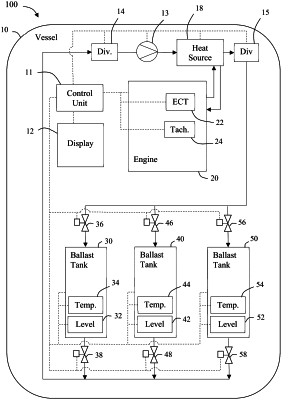| CPC B63J 4/002 (2013.01) [B63B 13/00 (2013.01); B63B 79/10 (2020.01); C02F 1/008 (2013.01); C02F 1/02 (2013.01); C02F 2103/008 (2013.01); C02F 2201/005 (2013.01); C02F 2209/006 (2013.01); C02F 2209/02 (2013.01); C02F 2209/42 (2013.01); C02F 2301/046 (2013.01); C02F 2303/04 (2013.01)] | 18 Claims |

|
1. A system for decontaminating ballast fluid of a vessel, said system comprising:
at least one ballast tank in said vessel, said at least one ballast tank dimensioned to receive and retain a volume of ballast fluid therein, each of said at least one ballast tank having a temperature sensor detecting and providing ballast fluid temperature information of said respective at least one ballast tank;
an input valve in fluid flow communication with said at least one ballast tank, said input valve selectively positionable between an open position providing flow of said ballast fluid into said at least one ballast tank and a closed position restricting flow of said ballast fluid into said at least one ballast tank;
an output valve in fluid flow communication with said at least one ballast tank, said output valve selectively positionable between an open position providing flow of said ballast fluid out of said at least one ballast tank and a closed position restricting flow of said ballast fluid out of said at least one ballast tank;
an onboard heat source located on said vessel in fluid flow communication with said ballast fluid when said input and output valves are open, said onboard heat source receiving said ballast fluid from said at least one ballast tank and transferring heat to said ballast fluid when received therein;
an auxiliary heat source located exterior to said vessel and selectively connectable to said vessel in fluid communication with said at least one ballast tank, said auxiliary heat source receiving said ballast fluid from said at least one ballast tank and transferring heat to said ballast fluid when received therein;
a first diverter valve in fluid flow communication with and upstream of said onboard heat source and a second diverter valve in fluid flow communication with and downstream of said onboard heat source, said first and second diverter valves selectively positionable to direct said ballast fluid to and away from a selected one of said onboard heat source or said auxiliary heat source;
a pump in fluid flow communication with said at least one ballast tank, said onboard heat source and said auxiliary heat source when selectively connected to said vessel, said pump (i) selectively activated to recirculate said ballast fluid between said at least one ballast tank and said selected heat source and (ii) selectively deactivated to cease recirculation of said ballast fluid, all based on predetermined ballast temperature conditions as detected by said temperature sensor in said at least one ballast tank; and
a control unit of said vessel in electronic communication with each of said temperature sensor, said input valve, said output valve, said first diverter valve, said second diverter valve, said pump, and said auxiliary heat source when selectively connected to said vessel, said control unit configured to:
(iii) detect whether said auxiliary heat source is selectively connected to said vessel;
(iv) provide operative signals to said first and second diverter valves to assume a first configuration directing fluid flow to and from said onboard heat source, and to assume a second configuration directing fluid flow to and from said auxiliary heat source when said auxiliary heat source is detected;
(v) selectively activate and deactivate said pump;
(vi) monitor said ballast temperature conditions within said at least one ballast tank through communication with said temperature sensor; and
(vii) generate at least one of a decontamination log and a decontamination record confirming decontamination of said ballast fluid in said at least one ballast tank.
|